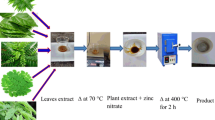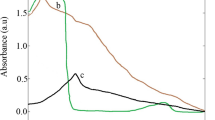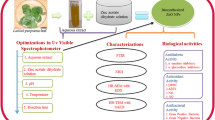Abstract
Bio-mediated synthesis of zinc oxide nanoparticles (ZnO NPs) was carried out by utilizing the reducing and capping potential of Andrographis paniculata leaf extract. The capped ZnO NPs were characterized using UV–Vis, XRD, FTIR, SEM, TEM and SAED analyses. FTIR analysis suggested the role of phenolic compounds, terpenoids, and proteins of A. paniculata leaf extract, in nucleation and stability of ZnO NPs. XRD pattern compared with the standard confirmed spectrum of zinc oxide particles formed in the present experiments were in the form of nanocrystals, as evidenced by the peaks at 2θ values. SEM and TEM analysis of ZnO NPs reveals those spherical and hexagonal shapes and the sizes at the range of 96–115 and 57 ± 0.3 nm, respectively. The synthesized nanoparticles possess strong biological activities regarding anti-oxidant, anti-diabetic, and anti-inflammatory potentials which could be utilized in various biological applications by the cosmetic, food and biomedical industries.






Similar content being viewed by others
References
Gilaki M (2010) Biosynthesis of silver nanoparticles using plant extracts. J Biol Sci 10(5):465–467
Raveendran P, Fu J, Scott L (2003) Completely green synthesis and stabilization of metal nanoparticles. J Am Chem Soc 125:13940–13941
Sahu AN (2013) Nanotechnology in herbal medicines and cosmetics. Int Res Ayurveda Pharma 4(3):472–474
Ramesh P, Rajendran A, Meenakshisundaram M (2014) Green synthesis of zinc oxide nanoparticles using flower extract Cassia Auriculata. J Nanosci Nanotechnol 1(1):41–45
Rouhi J, Mahmud S, Naderi N, Ooi CR, Mahmood MR (2013) Physical properties of fish gelatin-based bio-nanocomposite films incorporated with ZnO nanorods. Nanoscale Res Lett 8:364
Mittal AK, Chisti Y, Banerjee UC (2013) Synthesis of metallic nanoparticles using plant extracts. Biotechnol Adv 31:346–356
Kairyte K, Kadys A, Luksiene Z (2013) Antibacterial and antifungal activity of photoactivated ZnO nanoparticles in suspension. J Photochem Photobiol B 128:78–84
Kajbafvala A, Ghorbani H, Paravar A, Samberg JP, Kajbafvala E, Sadrnezhaad SK (2012) Effects of morphology on photocatalytic performance of zinc oxide nanostructures synthesized by rapid microwave irradiation methods. Superlattices Microstruct 51(4):512–522
Kumar SS, Venkateswarlu P, Rao VR, Rao GN (2013) Synthesis, characterization and optical properties of zinc oxide nanoparticles. Int Nano Lett 3:30. doi:10.1186/2228-5326-3-30
Sundrarajan M, Ambika S, Bharathi K (2015) Plant extract mediated synthesis of ZnO nanoparticles using Pongamia pinnata and their activity against bacteria. Adv Powder Technol 26:1294–1299
Elumalai K, Velmurugan S, Ravi S, Kathiravan V, Adaikala Raj G (2015) Bio-approach: plant mediated synthesis of ZnO nanoparticles and their catalytic reduction of methylene blue and antimicrobial activity. Adv Powder Technol 26:1639–1651
Shekhawat MS, Ravindran CP, Manokari M (2015) A green approach to synthesize the zinc oxide nanoparticles using aqueous extracts of Ficus benghalensis L. Int J Biosci Agric Technol 6:1–5
Mishra V, Sharma R (2015) Green synthesis of zinc oxide nanoparticles using fresh peels extract of Punica granatum and its antimicrobial activities. Int J Pharma Res Health Sci 3:694–699
Dobrucka R, Dlugaszewska J (2016) Biosynthesis and antibacterial activity of ZnO nanoparticles using Trifolium pratense flower extract. Saudi J Bio Sci 23:517–523
Bala N, Saha S, Chakraborty M, Maiti M, Das S, Basu R, Nandy P (2015) Green synthesis of zinc oxide nanoparticles using Hibiscus subdariffa leaf extract: effect of temperature on synthesis, antibacterial activity and anti-diabetic activity. RSC Adv 5:4993–5003
Manokari M, Shekhawat MS (2016) Biogenesis of zinc oxide nanoparticles using Couroupita guianensis Aubl. extracts—a green approach. World Sci News 29:135–145
Akbar S (2011) Andrographis paniculata: a review of pharmacological activities and clinical effects. Alter Med Rev 16:66–77
Kabir MH, Hasan N, Rahman MM et al (2014) A survey of medicinal plants used by the Deb barma clan of the Tripura tribe of Moulvibazar district, Bangladesh. J Ethnobiol Ethnomed 10:19
Li W, Xu X, Zhang H et al (2007) Secondary metabolites from Andrographis paniculata. Chem Pharma Bull 55:455–458
Harjotaruno S, Widyawaruyantil A, Zaini NC (2008) Apoptosis inducing effect of andrographolide on TD-47 human breast cancer cell line. Afr J Tradit Complement 4:345–351
Gupta S, Yadava JNS, Tandon JS (1993) Antisecretory (antidiarrhoeal) activity of Indian medicinal plants against Escherichia coli enterotoxin-induced secretion in rabbit and guinea pig ileal loop models. Int J Pharma 31:198–204
Tang W, Eisenbrand G (1992) Andrographis paniculata (Burm. f.) Nees. In: Tang W, Eisenbrand G (eds) Chinese drugs of plant origin chemistry, pharmacology, and use in radiational and modern medicine. Springer, Berlin, pp 97–103
Nanduri S, Nyavanandi VK, Thunuguntla SSR et al (2004) Synthesis and structure–activity relationships of andrographolide analogues as novel cytotoxic agents. Bioorg Med Chem Lett 14:4711–4717
Subramanian R, Asmawi MZ, Sadikun A (2008) In vitro α-glucosidase and α-amylase enzyme inhibitory effects of Andrographis paniculata extract and andrographolide. Acta Biochim Polonica 55:391–398
Sheeja K, Shihab PK, Kuttan G (2006) Antioxidant and anti-inflammatory activities of the plant Andrographis paniculata nees. Immunopharmacol Immunotoxicol 28:129–140
Wiart C, Kumar K, Yusof MY, Hamimah H, Fauzi ZM, Sulaiman M (2005) Antiviral properties of ent-labdene diterpenes of Andrographis paniculata Nees, inhibitors of herpes simplex virus type 1. Phytother Res 19(12):1069–1070
Akowuah GA, Zhari I, Mariam A (2008) Analysis of urinary andrographolides and antioxidant status after oral administration of Andrographis paniculata leaf extract in rats. Food Chem Toxicol 46(12):3616–3620
Tan BKH, Zhang A (2004) Andrographis paniculata and the cardiovascular system. In: Packe L, Ong CN, Halliwell B (eds) Herbal and traditional medicine, biomolecular and clinical aspects, vol 14. CRC Press, Boca Raton, pp 441–456
Visen PKS, Saraswat B, Vuksan V, Dhawan BN (2007) Effect of andrographolide on monkey hepatocytes against galactosamine induced cell toxicity: an in vitro study. J Complement Integr Med 4:10
Iruretagoyen MI, Tobar JA, González PA et al (2005) Andrographolide interferes with T cell activation and reduces experimental autoimmune encephalomyelitis in the mouse. J Pharmacol Exp Ther 312(1):366–372
Akbarsha MA, Murugaian P (2000) Aspects of the male reproductive toxicity/male antifertility property of andrographolide in albino rats: effect on the testis and the cauda epididymidal spermatozoa. Phytother Res 14(6):432–435
Lin FL, Wu SJ, Lee SC, Ng LT (2009) Antioxidant, antioedema and analgesic activities of Andrographis paniculata extracts and their active constituent andrographolide. Phytother Res 23(7):958–964
Murali M, Mahendra C, Nagabhushan Rajashekar N, Sudarshana MS, Raveesha KA, Amruthesh KN (2017) Antibacterial and antioxidant properties of biosynthesized zinc oxide nanoparticles from Ceropegia candelabrum L.—an endemic species. Spectrochim Acta A Mol Biomol Spectrosc 15(179):104–109
Tran PD, Batabyal SK, Pramana SS, Barber J, Wong LH, Loo SCJ (2012) A cuprous oxide-reduced graphene oxide (Cu2O–rGO) composite photocatalyst for hydrogen generation: employing rGO as an electron acceptor to enhance the photocatalytic activity and stability of Cu2O. Nanoscale 4:3875–3878
Oyaizu M (1986) Studies on products of browning reactions: antioxidative activities of products of browning reaction prepared from glucosamine. Jpn J Nutr 44:307–315
Patel Rajesh M, Patel Natvar J (2011) In vitro antioxidant activity of coumarin compounds by DPPH, super oxide and nitric oxide free radical scavenging methods. J Adv Pharm Educ Res 1:52–68
Sekar N, Sangeetha R (2014) Amylase inhibitory potential of silver nanoparticles biosynthesized using Breynia retusa leaf extract. World J Pharma Res 3(7):1055–1066
Karthik K, Bharath R, Kumar P, Priya VR, Kumar SK, Rathore RSB (2013) Evaluation of anti-inflammatory activity of Canthium parviflorum by in vitro method. Ind J Res Pharm Biotechnol 1(5):729–731
Gupta A, Srivastava P, Bahadur L, Amalnerkar DP, Chauhan R (2015) Comparison of physical and electrochemical properties of ZnO prepared via different surfactant-assisted precipitation routes. Appl Nanosci 5:787–794
Oladiran AA, Olabisi IAM (2013) Synthesis and characterization of ZnO nanoparticles with zinc chloride as zinc source. Asian J Nat Appl Sci 2:41–44
Vimala K, Sundarraj S, Paulpandi M (2014) Green synthesized doxorubicin loaded zinc oxide nanoparticles regulates the Bax and Bcl-2 expression in breast and colon carcinoma. Process Biochem 49:160–172
Senthilkumar SR, Sivkumar T (2014) Green tea (Camellia sinensis) mediated synthesis of zinc oxide (ZnO) nanoparticles and studies on their antimicrobial activities. Int J Pharm Pharm Sci 6(6):461–465
Sangeetha G, Rajeshwari S, Venckatesh R (2011) Green synthesis of zinc oxide nanoparticles by aloe barbadensis miller leaf extract: structure and optical properties. Mater Res Bull 46:2560–2566
ShivShankar S, Ahmad A, Sastry M (2003) Geranium leaf assisted biosynthesis of silver nanoparticles. Biotechnol Prog 8:1627–1631
Tas AC, Majewski PJ, Aldinger F (2000) Chemical preparation of pure and strontium and/0r magnesium doped lanthanum gallata powders. J Am Ceram Soc 83(12):2954–2960
Wahab R, Ansari SG, KimYS Dar MA, Shin HS (2008) Synthesis and characterization of hydrozincite and its conversion into zinc oxide nanoparticles. J Alloys Compd 461:66–71 (WHO 2014, malaria, fact sheet no. 94)
Elumalai K, Velmurugan S (2015) Green synthesis, characterization and antimicrobial activities of zinc oxide nanoparticles from the leaf extract of Azadirachta indica (L.). Appl Surf Sci 345:329–336
Shah MA (2008) Formation of zinc oxide nanoparticles by the reaction of zinc metal with methanol at very low temperature. Afr Phys Rev 2:0011
Salam HA, Sivaraj R, Venckatesh R (2014) Green synthesis and characterization of zinc oxide nanoparticles from Ocimum basilicum L. var. purpurascens Benth.-Lamiaceae leaf extract. Mater Lett 131:16–18
Yun SW, Shin YJ, Cho SG (1998) Somteromg Behavior and Electrical Characteristics of ZnO Variators Prepared by Pechini Process. J Kor Ceram Soc 35(5):498
Ryu JH, Lim CS, Auh KH (2002) Synthesis of ZnWO4 nanopowders by polymerized complex method. J Kor Ceram Soc 39(3):321
Vidhu VK, Philip D (2015) Biogenic synthesis of SnO2 nanoparticles: evaluation of antibacterial and antioxidant activities. Spectrochim Acta A 134:372
Madan HR, Sharma SC, Dayabhanu U, Suresh D, Vidya YS et al (2015) Facile green fabrication of nanostructure ZnO plates, bullets, flower, prismatic tip, closed pine cone: their antibacterial, antioxidant, photo luminescent and photo catalytic properties. Spectrochim Acta Part A Mol Biomol Spectrosc 152:404–416
Singh BN, Rawat AK, Khan W, Naqvi AH, Singh BR (2014) Biosynthesis of stable antioxidant ZnO nanoparticles by Pseudomonas aeruginosa rhamnolipids. PLoS One 9:e106937
Halliwell B (1997) Antioxidants and human disease: a general introduction. Nutr Rev 55(1 Pt 2):S44–S49
Egefjord L, Petersen AB, Bak AM, Rungby J (2010) Zinc, alpha cells and glucagon secretion. Curr Diabetes Rev 6(1):52–57
Nagajyothi PC, Ju S, Jun I, Sreekanth TVM, Joong K, Mook H (2015) Biology antioxidant and anti-inflammatory activities of zinc oxide nanoparticles synthesized using Polygala tenuifolia root extract. J Photochem Photobiol B Biol 146:10–17
Thatoi P, Kerry RG, Gouda S, Das G et al (2016) Photo-mediated green synthesis of silver and zinc oxide nanoparticles using aqueous extracts of two mangrove plant species, Heritiera fomes and Sonneratia apetala and investigation of their biomedical applications. J Photochem Photobiol B Biol 163:311–318
Liu HL, Dai SA, Fu KY, Hsu SH (2010) Antibacterial properties of silver nanoparticles in three different sizes and their nanocomposites with a new waterborne polyurethane. Int J Nanomed 5:1017–1028
Acknowledgements
This paper was supported by the KU-Research Professor Program of Konkuk University, Seoul, South Korea.
Author information
Authors and Affiliations
Corresponding authors
Ethics declarations
Conflict of interest
The authors declare that they have no competing interests.
Rights and permissions
About this article
Cite this article
Rajakumar, G., Thiruvengadam, M., Mydhili, G. et al. Green approach for synthesis of zinc oxide nanoparticles from Andrographis paniculata leaf extract and evaluation of their antioxidant, anti-diabetic, and anti-inflammatory activities. Bioprocess Biosyst Eng 41, 21–30 (2018). https://doi.org/10.1007/s00449-017-1840-9
Received:
Accepted:
Published:
Issue Date:
DOI: https://doi.org/10.1007/s00449-017-1840-9




